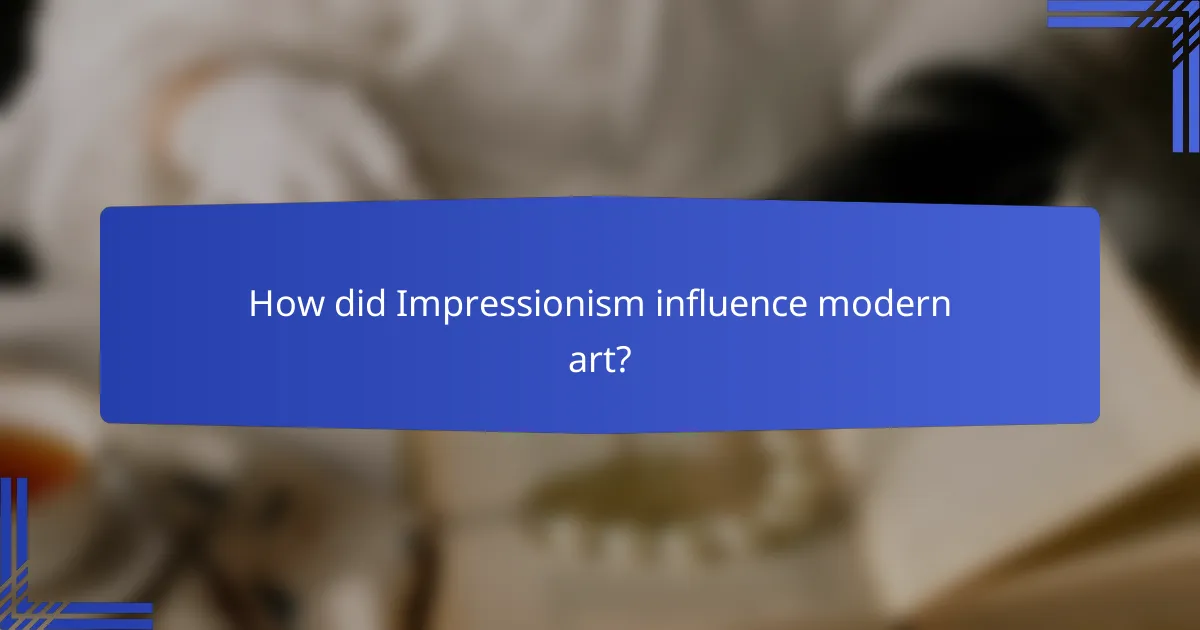Impressionism is an art movement that emphasizes the interplay of natural light and everyday scenes, capturing the essence of fleeting moments. Characterized by loose brushwork, it prioritizes perception and atmosphere over detailed realism, allowing artists to evoke emotions through their depiction of light and life.

How does Impressionism capture light effects?
Impressionism captures light effects by emphasizing the way natural light interacts with subjects, creating a sense of immediacy and atmosphere. Artists use techniques that allow them to depict fleeting moments, focusing on the changing qualities of light throughout the day.
Use of natural light
Impressionist painters often worked outdoors, a practice known as plein air painting, to observe and capture the effects of natural light directly. This approach allowed them to depict how light changes color and intensity at different times of the day. For example, the warm glow of sunset can transform a landscape, while midday light can create stark contrasts and shadows.
By prioritizing natural light, Impressionists aimed to convey the atmosphere of a scene rather than just its physical details. This focus on light contributes to a more dynamic and lively representation of everyday life.
Color theory application
Impressionists employed innovative color theories, particularly the use of complementary colors, to enhance the vibrancy of their paintings. By placing contrasting colors side by side, they created optical effects that mimic the way light interacts with surfaces. For instance, a bright yellow may be paired with a deep purple to make both colors appear more vivid.
This technique not only captures the essence of light but also evokes emotional responses, allowing viewers to experience the scene more fully. The strategic application of color is crucial in achieving the desired light effects in Impressionist works.
Brushwork techniques
Loose and rapid brushwork is a hallmark of Impressionism, allowing artists to convey movement and the transient nature of light. Instead of smooth, blended strokes, Impressionists used short, thick strokes that suggest the play of light on surfaces. This technique creates a sense of spontaneity and immediacy in their work.
Additionally, the varied application of paint thickness can influence how light is perceived in a painting. Thicker applications can catch light differently than thinner layers, adding depth and texture to the artwork. This approach invites viewers to engage with the painting from different angles, enhancing the overall experience of light effects.

What are the key characteristics of Impressionism?
Impressionism is characterized by its focus on capturing light effects, everyday scenes, and a loose brushwork style. This art movement emphasizes the perception of a moment rather than detailed realism, allowing artists to convey emotions and atmospheres through their work.
Everyday scenes focus
Impressionist artists often depicted ordinary life, choosing subjects like parks, streets, and domestic settings. This focus on everyday scenes allowed them to connect with viewers through relatable experiences and moments.
By portraying familiar activities, such as leisure time or social gatherings, Impressionists highlighted the beauty in the mundane. This approach marked a departure from the grand historical or mythological themes prevalent in earlier art movements.
Loose brushwork style
The loose brushwork style of Impressionism is essential for creating a sense of movement and spontaneity. Artists applied paint in quick, visible strokes, allowing colors to blend optically rather than physically mixing pigments on a palette.
This technique often results in a textured surface that invites viewers to engage with the artwork from a distance, where the brushstrokes merge into coherent images. The loose application also contributes to the dynamic quality of light and shadow, enhancing the overall impression of the scene.
Vibrant color palette
Impressionists utilized a vibrant color palette, often applying pure colors side by side to create luminosity. This method allowed them to capture the changing effects of light on their subjects, making the colors appear more vivid and alive.
Instead of relying on traditional dark outlines, they used color contrasts to define shapes and forms. This approach not only brightened their works but also reflected the natural world more accurately, as light alters the perception of color throughout the day.

Which artists are notable in Impressionism?
Several artists are pivotal to the Impressionism movement, each contributing unique perspectives and techniques. Notable figures include Claude Monet, Edgar Degas, and Pierre-Auguste Renoir, who focused on capturing light effects, everyday scenes, and employing loose brushwork in their artworks.
Claude Monet
Claude Monet is often regarded as the father of Impressionism, known for his innovative use of light and color. His series paintings, such as those of water lilies and the Rouen Cathedral, showcase how changing light affects perception and mood. Monet’s technique involved applying paint in short, quick strokes to create a sense of movement and spontaneity.
One of his most famous works, “Impression, Sunrise,” not only gave the movement its name but also exemplifies his focus on capturing fleeting moments. Monet often painted en plein air, or outdoors, to directly observe and depict the natural environment.
Edgar Degas
Edgar Degas is celebrated for his unique approach to Impressionism, particularly in his depictions of ballet dancers and everyday life. Unlike many of his contemporaries, Degas often worked in a studio, allowing him to carefully compose his scenes. His use of unusual angles and perspectives adds depth and dynamism to his work.
Degas was also known for his mastery of pastels, which he used to create vibrant, textured images. His paintings often convey a sense of movement, capturing dancers in mid-performance, and reflect his keen observation of human anatomy and emotion.
Pierre-Auguste Renoir
Pierre-Auguste Renoir is renowned for his vibrant depictions of social gatherings and intimate moments, often infused with warmth and light. His works, such as “Luncheon of the Boating Party,” celebrate the joy of life and the beauty of human connection. Renoir’s brushwork is characterized by soft, flowing strokes that enhance the luminosity of his subjects.
Renoir frequently painted scenes of leisure, showcasing the pleasures of everyday life in a way that resonates with viewers. His ability to capture the interplay of light and shadow creates a sense of atmosphere, making his paintings both inviting and lively.

How did Impressionism influence modern art?
Impressionism significantly shaped modern art by introducing new techniques and perspectives that prioritized light effects, everyday scenes, and loose brushwork. This movement encouraged artists to explore personal expression and spontaneity, paving the way for various art styles that followed.
Foundation for Post-Impressionism
Impressionism laid the groundwork for Post-Impressionism by challenging traditional artistic conventions. Artists like Vincent van Gogh and Paul Cézanne expanded on Impressionist techniques, emphasizing emotional depth and structural composition while retaining a focus on light and color.
This evolution allowed for greater experimentation with form and perspective, leading to diverse movements such as Fauvism and Cubism. The shift from capturing fleeting moments to expressing deeper meanings marked a significant transition in the art world.
Impact on abstract art
The influence of Impressionism on abstract art is evident in its emphasis on color and form over realistic representation. Artists began to explore the emotional resonance of colors and shapes, moving away from the need to depict recognizable subjects.
Movements like Abstract Expressionism drew inspiration from the spontaneity and brushwork of Impressionism, allowing artists to express their inner feelings through non-representational forms. This shift opened the door for a wide array of artistic expressions that prioritize individual perception and interpretation.

What are the common themes in Impressionist paintings?
Common themes in Impressionist paintings include the exploration of light effects, everyday scenes, and loose brushwork. Artists aimed to capture fleeting moments and the essence of their surroundings, often depicting urban life, nature, and social interactions.
Urban life representation
Impressionist artists frequently depicted urban life, showcasing the vibrancy and dynamism of city scenes. They captured bustling streets, cafes, and public parks, illustrating the modernity of the late 19th century. Notable examples include works by Claude Monet and Pierre-Auguste Renoir, which highlight the interplay of light and shadow in urban settings.
When exploring urban life in Impressionism, consider the use of bright colors and loose brushwork to convey movement and atmosphere. This approach allows viewers to feel the energy of the city, making it a key theme in many Impressionist works.
Nature and landscapes
Nature and landscapes are central themes in Impressionist paintings, with artists often painting en plein air to capture the natural light and changing seasons. They focused on the beauty of rural scenes, gardens, and waterways, emphasizing the effects of light on the environment. Monet’s “Water Lilies” series is a prime example of this theme.
In these works, the use of vibrant colors and quick brushstrokes creates a sense of immediacy and movement, allowing viewers to experience the beauty of nature as it changes throughout the day. This theme reflects the Impressionists’ desire to connect with the natural world.
Social gatherings
Social gatherings are another prominent theme in Impressionist art, often depicting leisure activities and interactions among people. Artists captured scenes of picnics, dances, and gatherings in parks, showcasing the joy of social life during their time. Works like Renoir’s “Luncheon of the Boating Party” exemplify this theme.
These paintings often feature groups of people engaged in conversation or enjoying leisure activities, highlighting the importance of community and social interaction. The loose brushwork and bright colors convey a sense of warmth and camaraderie, making social gatherings a vital aspect of Impressionist themes.
